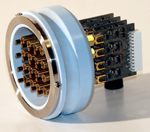- 25 April 2007
Heart monitor sets the pace for new inventions

The heart monitor, incorporating EPS technology

Monitoring developments: Dr Robert Prance at work in the laboratory
A new device that will allow doctors to monitor patients' hearts without even touching them could also soon be used to test carbon composite aircraft parts and microchips for defects more accurately and easily, thanks to new research by the inventors.
A team from the Centre for Physical Electronics and Quantum Technology in the Department of Engineering and Design at the University of Sussex has already successfully developed laboratory prototypes for these applications using electric potential sensors (EPS).
Similar devices, which measure magnetic fields, already exist. The EPS, however, offers a non-invasive way of measuring lesser-explored electric fields, which are present wherever there is electrical activity.
The monitor gives precise readings of electrical activity of the patient's heart without the need to connect the patient to equipment via pads and wires. A reading can be taken from the tip of a finger or remotely - a heartbeat can even be detected from up to a metre away in the laboratory. The aim is to simplify the procedure for acquiring high quality signals. The monitor is not commercially available yet and will be subject to patent licensing and further clinical trials in the near future.
Now the team - Dr Robert Prance, Dr Christopher Harland and Dr Helen Prance - has been awarded £762,000 by the Engineering and Physical Sciences Research Council (EPSRC) to investigate many areas for which EPS technology could be adapted, including other aspects of medical science, aviation, microchip manufacture and the automotive industry.
The four-year project, which follows on from a £1.1m EPSRC-funded (Basic Technology) research programme, will involve setting up pilot schemes with other scientists and businesses to develop a range of specific prototypes and test them.
Dr Robert Prance says: "This funding enables the Centre to consolidate research activity in a wide range of areas and to engage with appropriate academic and commercial partners. It is our belief that this non-contact technology will form the basis for new imaging instruments which will impact on both research and routine monitoring in many areas of science and technology."
The same technology has also been adapted to test for faults in microchip circuitry and even in stainless steel, carbon fibre composites and aircraft parts. EPS technology could also help to enhance MRI scanning techniques in hospitals.
Notes for editors
For further information, interviews or images, contact the University of Sussex Press office.
Press office contacts: Maggie Clune or Jacqui Bealing. Tel 01273 678 888 or email M.T.Clune@sussex.ac.uk or J.A.Bealing@sussex.ac.uk
For more information about the Centre for Physical Electronics and Quantum Technology at the University of Sussex, please see: http://www.sussex.ac.uk/pei/
For more information about EPSRC, please see: http://www.epsrc.ac.uk/default.htm